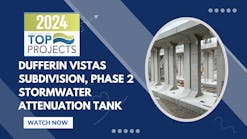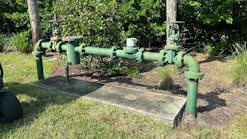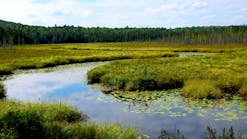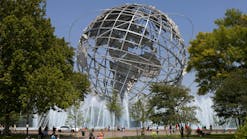Balancing Wetland and Stream Preservation With Stormwater Management Goals: A Case Study
In response to increasing regulatory authority over its water resources, the Maryland Department of the Environment (MDE) has combined various programs and processes into a “one-stop shop” where various issues can be addressed in a uniform and consistent manner. As part of this process, onsite conditions are assessed, potential primary and secondary impacts are identified, and mitigative practices are proposed sufficient to offset habitat loss and comply with water-quality standards. This is an effective approach when large-scale, complex projects are submitted for applicable wetland and waterway permits.
Experience has shown that balancing growth and transportation needs with resource and water-quality protection can also involve balancing various approaches within this process to achieve this goal. Specifically, avoidance and minimization requirements of wetland/stream protection programs might not necessarily be compatible with more traditional stormwater management (SWM) strategies. Further, MDE’s process may necessitate the consideration of requirements and practices that can exceed those required by the local municipality.
Presently, MDE regulates activities that may affect or impact water resources and features under the applicable regulations:
- Nontidal Wetlands: areas that are jurisdictional per 1987 US Army Corps of Engineers’ Manual and their 7.6-meter (25.0-foot) buffer
- Tidal Wetlands: tidally influenced open (“navigable”) waters and their wetlands
- Construction on Nontidal Waters and Floodplains: activities that can alter flow, current, or cross-section of streams and the 100-year floodplain
- Water-Quality Certification: Clean Water Act (CWA) Section 401 review of activity requiring federal authorization (e.g., Corps Section 404 permit)
Most federally regulated projects qualify for the corps Baltimore District’s atate programmatic general permit that, in effect, allows MDE to authorize many projects on the corps’ behalf.
Piney Branch Watershed
The development project discussed in this article is the first exampleóand therefore yields the most monitoring results–of several subsequent ones in a 405-hectare (1,000-acre) watershed, known as Piney Branch, in Montgomery County in the Greater Washington, DC, metropolitan area. This development is actually one of the first low-impact development approaches to water-quality management before the strategy was formalized in the industry. The initial project, submitted in 1989, proposed stream and wetland impacts for road construction and SWM ponds that were determined by MDE to be avoidable. Impacts were reduced and mitigated by design revisions and innovative approaches to wetland re-creation and SWM while accommodating the demands of a rapidly growing region. Subsequent development projects in this watershed are currently expanding in a manner that utilizes and refines data obtained from this initial project with completion expected by 2004. The positive outcome of this process is attributable to the following factors:
An effective partnering of engineering and ecologyInnovative best management practices (BMPs) and SWM strategies that will preserve more riparian habitat and minimize the violation of water-quality standards (especially temperature)A site-specific water-quality/stream-biomonitoring plan for the affected watershed to monitor BMP performance and develop state and county initiatives to coordinate future regulatory decisionsThe area lies in the Potomac River watershed between the Mid-Atlantic Piedmont region and the coastal plain. Soils are Glenelg-Manor associations and well drained, silty, and micaceous with occasional subsurface rock. Predevelopment land use was approximately 31% agricultural, 43% woodland, 9% residential, and 17% commercial (includes a crushed stone quarry). Some near-pristine areas remain in the lower reaches of the watershed. Woodlands are primarily deciduous hardwood forest, some of it being regenerative from previous clearing. The remainder was actively cropped field and shrubby intermittently cleared areas. Higher-quality wetland habitat occurred downstream of impact areas.
Some stream reaches exhibited accelerated bank erosion, filamentous algae, and poor invertebrate diversity. Other reaches were relatively absent of such indicators. Stream bottom substrate is composed of silt, sand, and fine gravel with transition to some cobble and rock in lower reaches. Although some groundwater contribution was evident, the riparian systems are primarily driven by surface drainage, some of it from offsite development without stormwater controls. Wetlands were primarily palustrine forested and palustrine scrub-shrub and contiguous to the streams. The MDE review of this development project began in 1989 with the first proposed impacts associated with road construction, lot fill, and regional SWM basins. The proposed activities required MDE and Corps authorization to proceed. Additional portions also requiring MDE/Corps authorization have been reviewed since then, and almost all of the areas are constructedóthe development sequence progressing up-drainage.
Methods
MDE determined the initial development proposal was subject to several regulatory criteria and had proposed wetland and stream impacts that were avoidable or could be further minimized. Initial habitat avoidance measures were applied under provisions reflecting federal CWA Section 404 guidelines, which showed that purpose and need for lot fill and in-stream SWM facilities had not been demonstrated. MDE determined that the remaining impacts associated with road access were acceptable with some minimization, such as narrowing of footprint, better crossing approaches, and bottomless structures. Because the proposed SWM strategies would convert the cooler wooded riparian stream system to warmer open water subject to pollutant loading and eutrophication, MDE further determined that the in-stream regional retention ponds were also incompatible with Maryland’s water-quality standards via the Water Quality Certification review.
Maryland’s waters are classified by four primary use designations with certain narrative and numerical criteria for maintaining designated uses (MDE 1995); P indicates additional use as water supply.
- Use I, I-P : water contact recreation and protection of aquatic life
- Use II: shellfish harvesting
- Use III, III-P: natural trout waters
- Use IV, IV-P: recreational trout waters
In addition, these standards include the USEPA-mandated Anti-Degradation Policy (ADP), which is a brief narrative standard stating that “certain waters of this State possess an existing quality which is better than the water quality standards established for them. ” To accomplish the objective of maintaining existing water quality ” nonpoint sources shall achieve all cost effective and reasonable best management practices for nonpoint source control.”
After some initial revision, the direct wetland and waterway impacts of the construction were sufficiently avoided, minimized, and would be mitigated with extensive onsite wetland creation, but the secondary impacts of accelerated stream flows, flood (quantity) management, and nonpoint-source pollution associated with inevitable upland development remained a challenge. The county had already approved this project because local SWM ordinances are not necessarily intended for onsite habitat protection but rather require flow management at the point drainage departs from the property.
In what ways could a continually increasing runoff curve be managed in a manner that will avoid the low-lying stream/wetland areas while allowing for reasonable use of property? The burden to manage for quantity (as opposed to just quality) entirely in uplands can be enormous and require a greater deal of developable property for storage. Indeed, this can be, and is, required by MDE in more unaltered and pristine watersheds as an alternative to in-stream SWM structures.
In certain situations, a more flexible approach may be warranted on a case-by-case basis where a moderate amount of SWM in wetlands and streams can occur with special mitigative requirements. Such situations typically include the following examples:
- Existing upstream land clearing and development before stormwater controls were requiredói.e., a retrofit situation, where existing water-quality indicators demonstrate ongoing impairment and degradation
- Stressed and previously disturbed habitat, such as accelerated bank erosion and altered species composition with little diversity
- The project having completed extensive local review and design prior to implementation of applicable environmental laws and regulations (a factor rarely applicable today)
- Existing land use activities continuing to be detrimental should the area not be developed with mitigative controls
Because some or all of these conditions were present in much of the watershed, MDE determined that to consider site-specific BMP strategies with moderate in-stream impacts desirable to the development effort is appropriate.
First, MDE requested that SWM strategies be re-evaluated from the beginning using the following hierarchy of preferred methods for quality control in upland areas where feasible:
- Infiltration via trenches, basins, or depressions
- Bioretention, filtering marsh/wetland, vegetated swales, sand filters, rain gardens
- Extended detention basin with wetland bottom
- Retention basin with wetland zone
The criteria would require a minimum of the first 1.27 centimeters (0.5 inches) of runoff, which removes 68%-90% of pollutants (MDE 1986) from the impervious surface (sometimes drainage area) to be managed by these practices before runoff is released into waters or wetlands. This would control the majority of first-flush pollutants, such as sediments, nutrients, hydrocarbons, and metals. Because postdevelopment runoff peaks are anticipated to exceed pre-existing conditions by a minimum of 10%, the applicable stormwater ordinance requires quantity management for the 2- and 10-year event at a minimum. As previously discussed, the logistics of doing this in numerous upland areas may not be practicable; therefore, a combination of the above-referenced quality control strategies with quantity practices would be acceptable. In other words, a smaller quantity of runoff could be managed for first-flush volumes only while the first-flush plus the 2- and 10-year volumes can be managed concurrently by an appropriately sized pond/wetland facility.
Through the analysis of boring logs, infiltration was found to be feasible in only limited portions of the site. The majority of the site was unsuitable due to impermeable soils [must have a minimum infiltration rate of 1.3 cm (0.5 in)/hr and a seasonally high water table within 1.2 meters (4.0 feet) or less of the bottom of a potential facility, steep slopes, or rock (MDE 1984)]. These areas appeared to be more suitable for conveyance to pretreatment practices, such as wetlands/marshes and ponds. Subsequently, the following mitigative practices and BMPs were proposed to MDE and accepted:
- Total wetland and waters impacts are limited to 1.02 hectares (2.52 acres) out of 8.34 hectares (20.60 acres) for the first 96-hectare (238-acre) property. Impacts are limited to road access, pond berms, and utilities only.
- Any in-stream SWM facilities would only occur in areas of marginal qualityói.e., waters that are pervious agricultural and intermittent channels.
- Minimum stream buffers of 30.5 meters (100.0 feet) would be observed.
- Wetland mitigation will be provided at a 2.3:1 replacement ratio along existing cleared riparian areas to reestablish a water-quality and riparian buffer.
- The 1.91 to 2.54 centimeters (0.75 to 1.00 inches) of stormwater runoff, which removes 82%99% of pollutants, from the drainage area will be managed entirely in uplands prior to release into waters and wetlands.
- Infiltration and filtration practices will be utilized for pretreatment in those areas that allow.
- Volumes beyond the first flush will be detained in the uplands where feasible and by in-stream embankments with a maximum detention time of 24 hours for the 10-year storm. The detention area behind the embankment temporarily stores water in the naturally occurring contour without excavation and clearing. Allowing the accelerated peak events to be attenuated without permanent pooling in the primary storage area can avoid degrading the wooded wetland resource upstream of the BMP. These specially designed embankments incorporate offline first-flush pretreatment areas in uplands on either side of the short-term in-stream storage area referred to as horseshoe ponds because of their plan view and visual depictions.
- Any areas of permanent stormwater pooling will be planted with wetland vegetation for water-quality enhancement.
During MDE’s public notice process, members of the local community were concerned that the water-quality and resource impacts may not be sufficiently avoided and mitigated. In addition, the Maryland Department of Natural Resources (DNR) informed MDE that the lower reaches of the property’s main stem Use I stream, Piney Branch, possessed characteristics of Use IV or possibly Use III waters. This is important because ADP requires that in such a situation the stream be afforded Use III or IV standards. With such standards, of particular concern are temperature increases and dissolved oxygen decreases associated with retention of stormwater, which not only violates the applicable temperature standards of 20°C (68°F) for Use III and 23.9°C (75°F) for Use IV but can be directly lethal to trout, the indicator species. Dissolved oxygen standards are 5 mg/lit. minimum for all waters. Unlike other areas of the country with natural cooler water lake systems (Maryland has none), streams can suffer from impoundment of flows (Galli 1990), (Schueler and Galli 1992). Therefore, MDE strongly discourages wetpond construction in Use III and IV waters.
The implications of such a finding could additionally affect the review process by requiring further reduction of development density along with impervious surface while utilizing more of the property for buffers and additional BMPs without any wetpond discharges. Because there was now sufficient reason to determine existing stream quality, DNR, MDE, and Montgomery County implemented their own assessment procedures using USEPA’s Rapid Bioassessment (RBA) (USEPA 1989) protocols, which showed that Piney Branch is a higher-quality Use I water but not adequate to sustain a Use IV recreational trout resource (DNR 1991), (MDE 1991), (MNCPPC 1991). This was confirmed by the inability of DNR to find one holdover trout during sampling a year after stocking.
Because of the higher-water-quality characteristics now documented in the lower reaches of the watershed, some continued public concern and the watershed-wide implications of this and forthcoming projects, the following additional water-quality management practices were proposed and accepted as conditions of the permit:
- A water quality monitoring plan will be developed and implemented throughout the build-out of the watershed and beginning with the first three SWM facilities proposed with this project to monitor effects of the development.
- A stream reach temperature model (Bartholow 1987) will be implemented to predict potential stream temperature increases and will be calibrated for improved accuracy as field data become available to estimate likelihood of exceeding Use IV temperature standards.
- A maximum of 20% of stream base flow will be diverted to any offline pretreatment areas of the horseshoe ponds or to acceptable in-channel ponds (i.e., 80% of natural base flow proceeds through or past the facility unaffected). The purpose is to allow for some flow into offline pooling areas during drought conditions to sustain wetland conditions and mixing while not depleting cooler base flow in-stream.
- All ponded and pretreatment areas, stormwater conveyance ways, and pond outlet structures will be planted with shade-producing species to the extent possible to minimize solar heating during summer.
- Impoundment structures will have “toe drain” pipes under the fill areas to release cooler perched water sources.
In addition, flows were calculated for Piney Branch and the discharge points of all three ponds for the minimum rainfall event that could pool behind the berm (QED), which is 4.45 centimeters (1.75 inches), as well as the 2- and 10-year events to determine percent contribution of potentially warmer water. Results showed a total contribution to base flow of 0.28% for the QED, 0.86% for the 2-year event, and 4.57% for the 10-year event, which would be negligible.
The water-quality monitoring requirement has two goals: (1) to compare baseline and postconstruction data to determine BMP effectiveness for future regulatory use and (2) to begin a local and state cooperative effort to determine appropriate and effective development and BMP criteria for future projects, as well as initiate a cooperative interagency review and water-quality assessment process. Quarterly reports are generated and provided directly to MDE and the county to aid in their local planning and decision-making process. Preliminary data are available for three stations (1, 2, and 6), and monitoring for ultimately six stations is planned (see figures). Stations 2 and 6 began three months prior to initial grading activities, and 1 and 3 were added in 1993. Initially, Station 2 began as the lowest point in the watershed, but Station 1 will eventually be the potential cumulative measure for the entire watershed.
Station 3 was added immediately downstream of a BMP on a tributary to Piney Branch that receives offsite input from a sand and gravel operation. Water-quality parameters being monitored in the field are dissolved oxygen, pH, turbidity, conductivity, stream conditions, and base flow, monthly from March to October. Water temperature is continuously recorded. Samples requiring collection and laboratory analysis are done for oil and grease and between November and February, inclusive for chlorides. The RBA Protocol II is used three times a year to assess benthic macroinvertebrates. Temperature and dissolved oxygen, the pertinent state numerical standards, along with the RBA, were required for MDE purposes. Additional parameters were included at the request of the county.
Results
The recalibrated stream temperature modeling yielded the following data for July 1991 based on climatological records to date (Loiederman Associates Inc. 1991). Existing conditions showed a mean of 22.8°C (73.1°F) and maximum of 24.6°C (76.3°F). Projected build-out conditions showed a mean of 23.2°C (73.8°F) and maximum of 24.9°C (76.9°F), which is acceptable. Final design and mitigation plans were provided, and the permit was issued with all aforementioned special BMP and mitigation conditions. The required water-quality monitoring report submissions were implemented beginning in 1992 (Loiederman Associates Inc. 19921996). While this study has generated and continues to generate a plethora of “keystone” regulatory data, the most pertinent are temperature, dissolved oxygen, and the RBA. The numerical standards for Stations 1, 2, and 6 and RBA studies for Station 2 are summarized in the table.
The site suffered severe adverse effects from a 10-year storm in 1993 resulting in out-of-bank flooding, alteration of channel morphology, and breaching of a beaver dam. In addition, severely polluted runoff from an offsite upstream mulch and debris disposal area (not part of the property) using water spray to cool potential spontaneous combustion had been discharging to the study area in 1994 and was corrected shortly thereafter. Since that time, the only anomaly occurring within the data period was a drought period from 1999 to 2002. The results to date do show that, despite these occurrences, dissolved oxygen concentrations were unexpectedly elevated during periods of higher temperature, and water-quality standards have not been significantly violated at the downstream locations.
The moderate stream impairment and the noncompliant spike of the 1996 T indicates items needing more scrutiny in subsequent measurement to determine whether this is a result of development activities or the 10-year storm and mulch pile runoff. More significant data will be available as cumulative indicators establish themselves. Monitoring results from the initial project will provide data not only on specific BMP performance but also on the vital long-term picture for the watershed because the property is at the lowest point. The other regulated projects’ up-drainage is also providing onsite monitoring, but the data from those efforts will provide information more for a particular BMP discharge or segment.
Conclusions
Allowing for the atypical storm and rainfall events and the temporary offsite discharge from the mulch storage property, the monitoring results and evaluation of onsite conditions indicate that the lower stream reaches of the property have sensitive water resources and can potentially be developed in a manner that complies with regulatory requirements for wetland and stream protection. Although this particular project required lengthy analysis and redesign, the lessons learned here will make subsequent projects proceed more efficiently. Should the additional monitoring data show further impairment and significant deviations from acceptable standards, additional BMP refinement and mitigative practices would be warranted for projects in this watershed.
More importantly, this project, along with the development review of the subsequent properties upstream, fueled state and county efforts to improve and strengthen local involvement in the permitting process and remove sometimes incompatible regulatory conflicts encumbering the regulated public. Since that time, Montgomery County has initiated and participated in the following interagency processes:
- Creating the county’s first local resource protection regulations by designating certain watersheds (Piney Branch being one of them) as Special Protection Areas, which limit development density and are subject to more consistent local review
- Creating the county Biosensitive Stream Crossing Committee, which develops road design criteria to avoid aquatic resource impacts
- Creating the county Biological Monitoring Workgroup, which coordinates and disseminates information from local water-quality and stream-monitoring efforts
- Creating the MDE/Montgomery County collaborative pilot program to review projects concurrently under the auspices of the Interagency Wetlands Coordinating Committee
Some of the initial results of these coordination efforts have been efficient and equitable review of the remaining projects in the Piney Branch watershed in a manner that has avoided most, or all, jurisdictional impacts while managing runoff entirely in uplands. What has been learned from this project continues to be used and refined within the context of the interagency review efforts.





